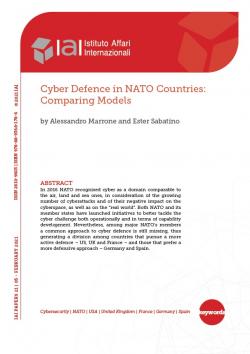Cyber Defence in NATO Countries: Comparing Models
In 2016 NATO recognised cyber as a domain comparable to the air, land and sea ones, in consideration of the growing number of cyberattacks and of their negative impact on the cyberspace, as well as on the “real world”. Both NATO and its member states have launched initiatives to better tackle the cyber challenge both operationally and in terms of capability development. Nevertheless, among major NATO’s members a common approach to cyber defence is still missing, thus generating a division among countries that pursue a more active defence – US, UK and France – and those that prefer a more defensive approach – Germany and Spain.
Translation of La difesa cibernetica nei Paesi NATO: modelli a confronto, Rome, Senate, December 2020 (Approfondimento No. 164)
-
Details
Rome, IAI, February 2021, 36 p. -
In:
-
Issue
21|05 -
ISBN/ISSN/DOI:
978-88-9368-176-6
Introduction
1. The NATO framework
1.1 An evolving approach, strictly linked to collective defence
1.2 NATO structures relevant to cyber defence
1.3 The development of military doctrines and capabilities
1.4 NATO partnerships with the private sector and the EU
2. The United States
2.1 The Pentagon’s strategy: Persistent engagement and forward defence
2.2 The evolution of the US Cyber Command
3. The United Kingdom
3.1 National strategy
3.2 Offensive cyber operations
4. France
4.1 Cyber strategy and operational structure
4.2 International and industrial sector cooperation
5. Germany
5.1 The Cyber Strategy’s operational division and legislative limits
5.2 Attention to international law and cooperation
6. Spain
6.1 Strategic update and the restructuring of the armed forces
6.2 Industrial cooperation and training
Conclusions
References
List of interviewees
List of acronyms
Topic
Tag
Related content
-
Publication21/12/2020
La difesa cibernetica nei Paesi NATO: modelli a confronto
leggi tutto



